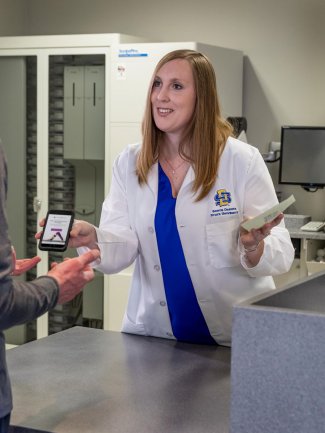Putting people addicted to meth on the road to recovery is the goal of the Stigma, Treatment, Avoidance and Recovery in Time Program for Psychostimulant Support (START-SD-PSS) in Rural South Dakota.
The three-year, $500,000 Health Resources and Services Administration (HRSA) project seeks to give patients age 25 to 54 and their families greater access to effective prevention, treatment and recovery services, according to South Dakota State University assistant professor Erin Miller, who leads the START-SD-PSS project.

Miller is also co-director of an HRSA project focused on opioid use disorder, known as START-SD, which began last fall. Both projects are part of research done through SDSU’s Community Practice Innovation Center, which uses a community-based, holistic approach to connect patients with services that will improve their quality of life.
“We know when someone is using substances, it’s usually more than one substance. The top three are alcohol, opioids and methamphetamines, also known as psychostimulants,” explained Miller, who is a faculty member in SDSU’s Department of Allied and Population Health. “This grant allows us to do additional work specifically geared toward psychostimulants that could not be addressed through the opioid project.”
Other team members are assistant professor Aaron Hunt of the Department of Allied and Population Health, who directs the opioid project; associate professors Jennifer Ball and Jeremy Daniel of the Department of Pharmacy Practice; and professor Mary Emery of the School of Psychology, Sociology and Rural Studies
“Having an interdisciplinary team helps strengthen the research we are doing,” Miller said. Measuring success comes back to “improving outcomes. How many people are staying in treatment? How many patients are taking advantage of the services offered? How many are using educational sessions for community and professional development to learn more about the disease of addiction?”
Coordinating services, offering incentives
“We are doing great work with opioids, but we need to expand our services to help those addicted to other substances,” Miller said. While the number of overdose deaths due to opioid misuse in South Dakota has had a downward trend over the past year, the number of deaths due to meth overdoses has risen sharply in the first two quarters of 2021, according to provisional data from the South Dakota Department of Health.
The psychostimulant project will work with patients and their families in four targeted counties—Brown, Codington, Roberts and Hughes. Through the grant, the research team will offer incentives for patients to enter and stay in treatment. “The longer someone is in treatment, the greater the likelihood of long-term success,” Miller said.
Key partners are Avera St. Luke’s Hospital in Aberdeen, South Dakota Urban Indian Health and Avera St. Mary’s Hospital in Pierre and Coteau des Prairies Health Care System in Sisseton. In addition, Face It Together, a national addiction support program that has an office in Sioux Falls, will offer peer coaching in person or by telephone or video.
“We have individual organizations working to move the needle, but each piece is very disconnected. We need to bring the support systems together,” Miller said. Through the grant, the research team will hire a care coordinator to “sew the pieces together,” building a referral map and identifying and addressing gaps in each county. A postdoctoral researcher will also work this and other research projects through CPIC.
“The value of the center is having a network of resources and experts that can help put the pieces together,” Miller said.
Fighting stigma, rebuilding families
The stigma associated with meth addiction is a huge barrier to treatment throughout the state, Miller said. “If you are afraid of losing your job, you will not seek treatment. If you are treated negatively when you come to a health care office (to seek help), you will not come back. When your mom or brother says, ‘just figure it out, just stop using,’ you will try to do it yourself without the treatment and support system that can help you be successful.”
However, Miller continued, “Over time, meth impacts a person’s brain. Due to chemical and structural changes in the brain, people lose the ability to make those decisions. They cannot go back to the way they were physically because that is not what their bodies are anymore. The part of the brain that helps them make that decision and gives them the will power to stop using becomes damaged.”
While medication-assisted treatment can help those recovering from opioid addiction, nothing has been approved to help those addicted to meth and other psychostimulants.
Those in recovery report what they describe as an “I never feel joy” feeling when they stop using meth. “Meth increases the release of dopamine, which plays a role in how we feel pleasure and motivation,” Miller said. Meth is long-acting with 50% still in the body after 12 hours compared to cocaine which has 50% removed from the body after just one hour.
“Exercise is the only thing that has shown evidence of helping patient start feeling good again,” Miller said. Therefore, the researchers will refer patients so they can participate in exercise programs.
Furthermore, one of “the driving factors for patients seeking treatment is because they want to be there for their families,” Miller said. Therefore, the STATE-SD-PSS program will work with families to help rebuild relationships damaged by addiction. For that, the researchers will tap into programs, such as Strengthening Families, an evidence-based family skills training program.
“At the end of the day, we want people to be healthy, well and alive,” Miller concluded.
Republishing
You may republish SDSU News Center articles for free, online or in print. Questions? Contact us at sdsu.news@sdstate.edu or 605-688-6161.

